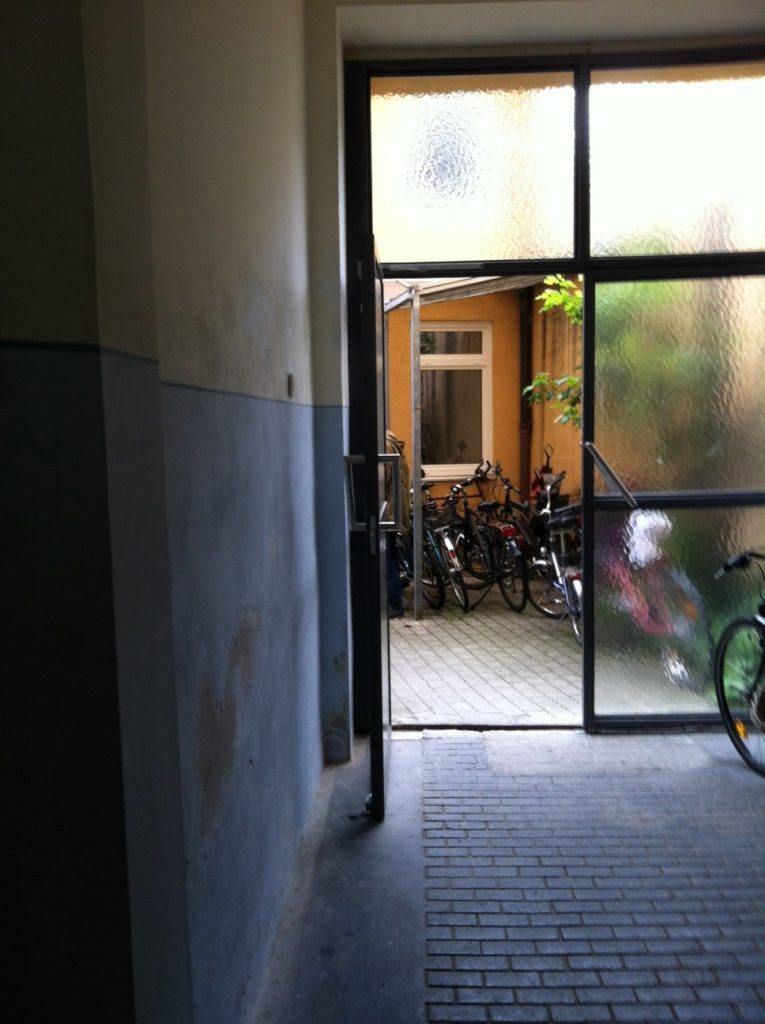I have followed Kunstraum München for some time and now that I’m here have been eager to investigate, a plan somewhat impeded by the Verein’s tendency to announce events through the city (which supports the venue/group for contemporary art and criticism – its 40th anniversary is this year) i.e. a bit slowly, and sporadically through a social media platform owned by someone with the initials MZ I do not often participate in (more on social media at the end), and also since I am often busy on the Wednesdays when meetings and lectures take place.
In any case being free on Pfingstenmontag allowed a friend visiting from Brussels and I to haunt tonight’s talk „Warum im Kollektiv?“ by members of Hamburg’s 8. Salon. Visually this also served as a near-to-closing reception for the Mahlergruppe Austellung Of Two Minds (the actual end date is 26 May). You can see some Mahlergruppe work on its low-key Website. The emphasis on group (founded in 2008 at Munich’s Akademie der Bildenden Künste) and the lack of artists’ statements and biographies is very refreshing, and the powerful graphite-and-acrylic bilder – somewhere between drawings and paintings, are, to me distinctively Munchneresque.
Of Two Minds also includes a sculpture, Bellestar, a craft of formed and draped corrugated framing, and a few photographs of Zurich’s “Needle Park,” circa the 1980s and 1990s at the beginning and then height of needle-borne infection. Of Two Minds isn’t a conceptually straightforward rumination on dystopia, though. Perhaps as the name implies it asks about how we remember these types of weirdly hermetic thought/images that may or may not be indexical. (Of course for Americans the first thing that comes to mind is Al Pacino’s laconic junkie in Panic in Needle Park, the film school staple from 1971.) Thinking about how much Zurich has changed in the past decades doesn’t diminish these images which aren’t exactly memories, though they do form the strong impression of something personally experienced (another film analogy would be the impression of Marseille and Brest from The French Connection and Querelle, though the French coastal cities haven’t been like that in … forever, and were already “not like that” when Genet was writing and Fassbinder and Friedkin were filming).
In Bavarian, the word “cliquish” (cliquenhaft) doesn’t have a pejorative meaning; however the vibe at this particular talk had an overtone of Williamsburgian insularity to it, in the form of a majority of Arcade Fire-years hipsteren on hand who already knew one another and were incurious about interloping French speakers, and even a bit indifferent to the Hamburgers. (To be fair we were not roving about giving the single-handshake greeting either.) Still this is an enticing venue for new ideas in a nice atelier on Holstraße, so when I am not juggling a tri-lingual communication situation, I will go back.
In her curator’s notes on Of Two Minds, Sabine Weingartner, in sussing out the implications of the provocative title, evokes, among other associations, “the third minds” as proposed by Beat collaborators William Burroughs and Brion Gysin. I think Burroughs and Gysin (particularly the latter) would be furious with their inheritor and former protégé Genesis B. P-Orridge. I suppose it’s not surprising that people who survive extreme movements (i.e. Abbie Hoffman) are eventually forced to capitalism (though actually I do not believe this is inevitable). GBPO, of extreme body modification and Throbbing Gristle fame, is a terrible disappointment though, severing his connection to V.Vale’s collaborative ReSEARCH Publications and being so parsimonious with his Twitter-following activities [36/6040]*. You would think a founding industrial musician whose legacy is nonetheless somewhat in question would want to connect with as many seekers as possible, yet this is not the case.
I am perplexed when artists and artist collabos use social media poorly. Twitter, with its relatively uncluttered interface and its deep data use of searchable hashtags (now with the allure of “verified” accounts) is currently the going platform for arts communication. I predict however that the stinginess of mutual followship will discourage nascent users. Artists in particular need art students, curators, and art historians to feel a connection to their work (I’m talking to you Trevor Paglen [74/1166]*, Olafur Eliasson [166/3646]*, and Cory Arcangel) [217/13433]*. I’m particularly talking to one of my very favorite contemporary artist/activists, Dread Scott who is the stingiest [9/36]* of Twitter account holders amid those who could to so much more. Many people, including myself, were completely galvanized by Scott’s appearance this past February at CAA (also notoriously miserly with the follows) and stunned by both the passion and “rightness” of his work. Still, I’m pretty sure Scott knows Cornel West [142/493,852]* and can just text West at will. Why the, um, very narrow range of contacts in this wide-open medium?

 RSS - Posts
RSS - Posts